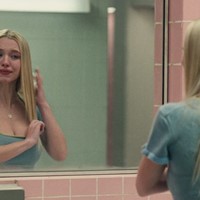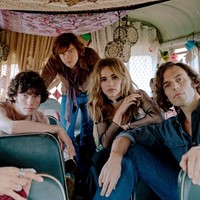The hairstylist opens up about his journey from the son of Vietnamese refugees working in his mother’s salon to being Oscar-nominated for House of Gucci
Forget plot, dialogue, acting – in House of Gucci Patrizia Reggiani’s (Lady Gaga) hair is the real star of the show. A force of nature and a vehicle of narrative expression in its own right, you can trace the story arc through the hair, from the youthful soft waves the character starts off with to the power perm that accompanies Patrizia’s later machinations. It all comes courtesy of one man: Gaga’s longtime hairstylist Frederic Aspiras. “I love the art of storytelling, whether it be in film or in music or fashion,” he says. “It’s something I will always do, I believe I am a storyteller through what I do with hair.”
Throughout their 13 years as collaborators, Gaga and Aspiras have created some truly remarkable looks, from hair bows to Elvis Presley-inspired sideburns. For House of Gucci, however, they took it to a whole other level, creating 54 hair looks for Patrizia using 10 different wigs (director Ridley Scott originally wanted to use just two). Aspiras famously spent months compiling a 450-page directory full of research mapping out each look.
It’s no wonder then that Aspiras has been nominated for an Oscar for his work on the film. After 25 years working in the industry, the nomination has been emotional for him, made even more so by the fact that his mother passed away six months before filming began. A hairdresser herself, it was her that taught Aspiras many of the classic period-correct techniques he used in the film; old-school methods like wet sets, backcombing, pin curls and spiral perms. The film, he says, was a love letter to her.
Here Aspiras shares his journey, from learning his craft in his mother’s salon and being broke in Los Angeles, to working with Paris Hilton and his relationship with Lady Gaga.
Can you tell us a bit about yourself and where you grew up?
Frederic Aspiras: I was born in San Francisco, California. My mother’s Vietnamese and my father’s Filipino; they were refugees from the Vietnam War. My mother was a hairdresser and that led me to be exposed to a lot of the business of beauty. I started off doing hair when I was 13-years-old working at her salon. It was pretty rare for an Asian woman in the 80s to have their own business.
Being the youngest of seven children, being gay, and being closeted in the early 90s was not quite like how it is today – we didn’t have that social media support. If we were to say anything, even in my family, you would be ousted. So I kept it a secret for a long time. I also kept a secret that I knew how to do hair for a long time; only my mother knew.
Why are you a hairstylist? What made you want to become one?
Frederic Aspiras: I really loved the transformation process and making people feel good. I used to watch my mom interact with customers at her salon and she had a certain way of really being compassionate and healing with her touch and her words.
As I got older, there was not any kind of plan or anyone’s footsteps to really follow: there was only Kevyn Aucoin at that time. I went to meet him once at a bookstore! It was just me and him at the end of the night, and he wrote this beautiful passage when he signed my book: just keep making the world beautiful. When you grow up in the environment I did, where my parents fled here from a war-torn country, there’s nothing else to lose. And I tell that to so many young, aspiring artists that want to follow in my footsteps: create your own footsteps! Try to figure out what you like and try everything out.
Where did you learn your craft?
Frederic Aspiras: I was a make-up artist first. I started as a counter person and I went all the way to almost becoming a global trainer for NARS Cosmetics. But I gave it up right when they offered it to me. This is where the two roads split for me. Life is about that: you don’t realise the opportunities that are around the corner, and sometimes the road less travelled is the way you want to go.
I got off the phone with NARS and then two weeks later, I hopped on a plane and moved to Los Angeles. I fell flat on my face. Everybody shut their door and said nope, you have no experience. I was literally sleeping on people's couches for six months. At one point I was living in a hotel for $90 a week in downtown LA, I had barely $20 in my pocket. $20 in my pocket and a dream. I cried every night when I got home, I didn’t tell anyone I’d failed. I thought my dream was over.
How did you get your big break?
Frederic Aspiras: Three years later, I got a phone call from an agent – the same agent I am with today – Kent Belden. He knew about my work because I had done little jobs here and there and he said he needed somebody who could help work with Paris Hilton. She was about to start up a new TV series called My New BFF. I worked with her for three and half years after that.
When did you first start working with Lady Gaga?
Frederic Aspiras: I was taking a break in 2008. I was exhausted. I got a phone call again from Kent and he said: ‘This new artist named Lady Gaga is looking for somebody to do her hair for tour.’ I had just seen her bleeding on stage at the VMAs and thought she was like a new David Bowie. When I first met her, she was so different. She was just emerging, starting to blow up. While we were on tour, the “Bad Romance” video came out and then everything changed overnight. Ever since then it’s been non-stop: non-stop touring, non-stop films, fashion, everything.
What was it that drew you to hair when you were deciding between hair and make-up?
Frederic Aspiras: Before Gaga, I was still doing Paris’s hair and make-up. I was a rare breed in Los Angeles. And even still today, I did the hair and make-up for the Variety cover with Gaga because Sarah wasn’t available. It still is my passion, but sometimes you just have to let life take you on a journey. You can’t control what's going to happen, you can only prepare. I studied every reference from every hairdresser, every photographer, every fashion magazine. I used to sit in the Virgin Records store and read every single magazine from Tatler to Vogue to really understand my craft. You have to understand what the stylist is trying to convey, you have to understand photography, lighting. You're working as a team, so you have to understand what they're talking about.
With Gaga, in the beginning, I was told I was going to do both hair and make-up. But looking at it now, I don’t think that would have worked out, especially with the concepts that I was coming up with. I have, literally, a warehouse of thousands of wigs that I archive for her. Each wig that you see has not been reused, it's been kept in an archive. We put them in the Las Vegas museum, all the wigs that have been on all her tours. The fans love it because they get to just walk down memory lane again.
Congratulations on your Oscar nomination for House of Gucci!
Frederic Aspiras: Thank you. Can you believe it? I've been working since 1997, putting my head down and just working and sacrificing not seeing family. I was up at 5am in the morning watching the nominations and when they announced House of Gucci I cried like a baby for a good hour. This wasn’t just a movie for me. My mother had passed away six months before filming and she was my inspiration.
When my mum passed I wanted to give up, but Gaga said we have to do this for your mom, we have to honour her. I spent six months alone in my house making all 15 wigs by hand. I just completely immersed myself into preparing for the film, because I wanted to write this love letter to my mom. This is one way I kept her spirit alive, through this film. I’m sad because I couldn’t share this in real life [with her] but I know she’s part of this success. I know she’s part of this nomination.
While you were researching for the movie, you interviewed locals and watched Italian films from the time. What did you learn through that process?
Frederic Aspiras: Patrizia is not well known, there are not photos of her everywhere. So a lot of the work I had to do was creating my own forensics of her looks. I really wanted to stay as honest and as accurate as possible, so I did a lot of research on what Italian women would have been influenced by at that time. What was pop culture like for them in the 70s? My references were real-life references; things I researched by interviewing women in Italy. At that time, Italy was still doing a lot of the late 60s style. Then I took it a step further into texture, I used the same types of techniques, the type of hairspray, the colour.
Many people have said the hair in the movie is its own character. How does it help tell the story?
Frederic Aspiras: When you watch the movie you see a progression, you see a distinction in the periods in the decades. That’s when Gaga can use the tools that I provided her. She has many other tools to really delve into for characterisation but one of them was her wigs because it really changed her look. In the movie, there is a graduation of colour which traces her life from starting off being middle class to becoming super-rich. The styles become ultra-luxe and the inspirations change. Dynasty was a big show in Italy in the 80s, so a lot of influence came from Joan Collins.
Every morning we did a four-hour transformation in the trailer. Gaga gave us her direction and how she was gonna play Patrizia that day, which changed the way I styled the hair. I had a preconceived notion of what I thought from reading the scripts, but she also had an underlying script. So a lot of it changed as we were going, it became a really beautiful relationship with my actor and I, and the make-up artist.
How does the plot or the emotion that the character is feeling translate into hair? If someone’s feeling angry or sad or determined, how does that become a style?
Frederic Aspiras: Okay, so for instance, Patrizia is going to the reading of the will, she’s in a room full of men who dominate the whole business, and she knows that she can’t rely on the weakness of Maurizio. What I wanted to convey with the hair was a sense of power change. She went from soft, virgin brown hair to really dark black hair; a frizzy perm. I pulled it up to the side and I gave her this 80s power hairstyle that you see in a lot of businesswomen.
She wasn’t a meek wife: she was there to forge a signature, to get a stake in the company. If I had given her a bow and a low bun and made it look really neat, how would you believe that this woman could pull off something like this? She doesn’t look the part. No one will take her seriously. She has to feel powerful. Had she looked very sweet, with really soft brown hair and just looked like she’s a mother, that wouldn’t work in the world of the Gucci empire, a bunch of men. She couldn’t speak up to people like that, she had to really play the part. She had to be confident.
Do you see how the hair can change the way the scene feels? If I gave her a top knot, it would have been different, if I made her hair straight it would have made her look very meek. The frizzy perm was a huge fight because they didn’t want her to look ugly. But the perm in the 80s, ask your parents or your grandparents, it was a big deal. Especially if you were rich, it was for people who could afford perms because they were expensive.
So it’s not just reading the story but listening to the story. I tailored the hair to the emotion and the intention of what the scene was going to bring, how she was going to play it. If you watch any movie that has really amazing hair, like Pretty Woman, if Julia Roberts came out in that red dress and her hair was down and frizzy or like boring and brown, she wouldn't have played that part as well. Hair changes so much of the mood, it adds to the narrative, the storytelling of it; it really helps facilitate the narrative of the character. That’s the difference between movie hairstyling and everyday hairstyles.




